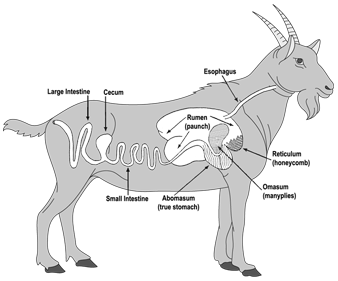Here are a few types of the food digestion system found in the animals.
Besides the rabbit and cows in Biology Textbook Form 4, we will like to show the others animals digestion system.
Before that, let us explain what is "ruminant digestion".
The fact that the ruminant can convert roughages, unsuitable for man, into useful products is normally taken for granted. What enables them to achieve this? The ruminant has three preliminary compartments in its digestive tract before the true stomach, or abomasum. These are the reticulum, rumen, and omasum. The rumen, and reticulum are not completely separated, but have different functions.
Reticulum
The reticulum is a flask-shaped compartment with a "honeycomb" appearance. It moves ingested food (ingesta) into the rumen and the omasum. The reticulum also causes the regurgitation of ingesta during rumination, and acts as a collection compartment for foreign objects.
Rumen
The rumen is a large fermentation chamber (in adult cattle its volume is about 125 litres) which has a very high population of micro-organisms, mainly bacteria, but also protozoa.
It is because the bacteria secrete the enzymes necessary for cellulose degradation that ruminants are able to utilize roughage. The rumen has a textured surface, lined with projections (up to 1 cm long), termed rumen papillae. The rumen, along with the omasum, absorb the by-products of bacterial fermentation. These by-products are volatile fatty acids (VFAs).
Omasum
The omasum, or "manyplies", contains numerous laminae (tissue leaves) that help grind ingesta. These folds assist in the removal of fluid from the ingesta on their way to the abomasum.
Abomasum
This compartment corresponds to the stomach of the non-ruminant, and is termed the true stomach. It secretes the gastric juices which aid in digestion. The pH of the abomasum is normally in the range of 2,0 to 2,5. This low pH facilitates initial protein breakdown, and kills the bacteria which have spilled over from the rumen.
Digestion of carbohydrates
Plant tissues contain about 75 per cent carbohydrates of one kind or another, and provide the primary source of energy for both the ruminal organisms, and the host animal.
In ruminants the major part of all carbohydrates, including the complex carbohydrates such as cellulose and hemi-cellulose, is digested by bacterial action in the rumen.
During microbial digestion an appreciable amount of methane gas is produced. Approximately 6 to 7% of the food energy of the ruminant is lost as methane.
The main end-products of carbohydrate digestion are volatile fatty acids. Of these, acetic acid forms the major proportion, followed in declining order by propionic, butyric, and valeric acids. The VFAs are absorbed into the bloodstream through the rumen wall, and constitute 66 to 75% of the energy derived from the feed. Carbohydrates, such as sugars and starches, that escape ruminal digestion are digested in the abomasum, and the end-products are absorbed through the small intestine.
Digestion of protein
Dietary protein, like dietary carbohydrates, is fermented by rumen microbes. The majority of true protein, and non-protein nitrogen (NPN), entering the rumen is broken down to ammonia, which bacteria require for synthesizing their own body protein. Ammonia is most efficiently incorporated into bacterial protein when the diet is rich in soluble carbohydrates, particularly starch. Ammonia, in excess of that used by the micro-organisms, is absorbed through the rumen wall into the blood, carried to the liver, and converted to urea, the greater part is excreted in the urine. Some urea is returned to the rumen via the saliva, and also directly through the rumen wall.
The undegraded true protein fraction, plus the microbial protein, passes from the rumen to the abomasum, where it is digested, and absorbed into the bloodstream through the walls of the small intestine.




No comments:
Post a Comment